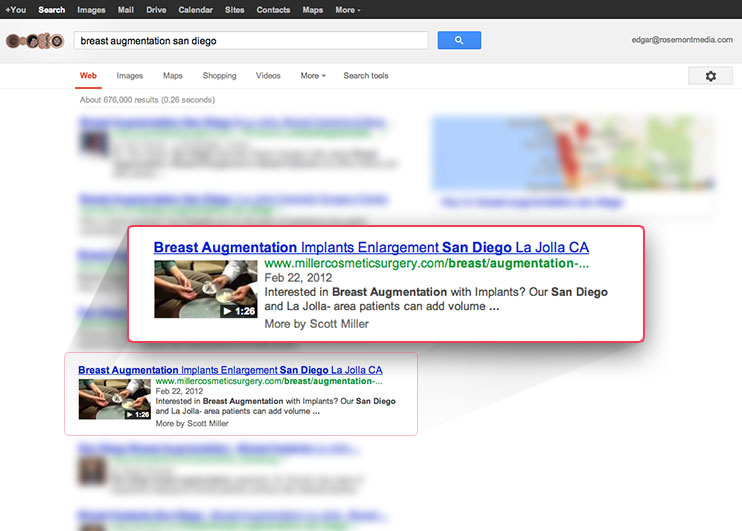Does Video Help SEO?

Our clients will often ask us if adding videos to their websites will help boost their rankings. Generally speaking, the answer is yes, but only if done correctly. Video SEO can be quite complex, and this post will be addressing two issues that can have a significant impact on rankings: the type of video platform, and how to integrate YouTube videos with a practice website.
How Video Helps SEO:

Video thumbnails displayed in search results can make a listing stand out.
The goal of search engines is to show the most relevant search results. To simplify things, the more the content matches the search (among many other variables), the better rankings a page will have. Search engines crawl the code and content of websites to determine if a page relates to a search.
Furthermore, video properly embedded on a website offers a means to stand out among static text listings since Google often times displays a video thumbnail as part of the listing. Videos are currently displayed on the Web search tab in Google and on the video results page, allowing for broader brand visibility.
Additionally, video coded in the HTML5 language is more easily read by search engines, and if the video title matches the content on the page (again, many variables affect this), it could help improve your ranking.
Types of Video Delivery:
Videos can be embedded directly onto a webpage. While there are technically two ways to do this, only one is standard these days. Flash is outdated but still present in older sites, while HTML5 is the current standard and best practice for embedding video.
Flash: The Past
Flash is the old method of adding video and was made virtually obsolete in 2011 when Apple products stopped supporting it. Flash videos still exist on websites, but any mobile device running on iOS – such as iPhones and iPads – won’t display the videos. Also, the code for Flash videos isn’t crawled as easily as HTML5, so site rankings may not be as good as if the video were coded in HTML5. Essentially, using Flash today is like using a flip phone; impractical and approaching extinction.
HTML5: The Present
The current markup language, HTML5, should be every website’s means for adding self-hosted video. Unlike Flash, HTML5 is supported by all web browsers. In addition, it benefits the site’s SEO by allowing keywords in the video code to be crawled by search engines. As mentioned before, it is the preferred means to add video.
Should Videos Be Embedded on Practice’s Site or Left on YouTube?
YouTube is a helpful platform to add to a practice’s SEO arsenal, but it shouldn’t be disconnected from the main practice site. A YouTube channel can help a brand expand its online presence, but it shouldn’t be expected to be a major lead generator. People are overwhelmingly going to search for doctors and procedures on Google, not YouTube.
Following the idea that search engines prefer a concentration of relevant content, it is a best practice to embed a video on a practice site. Adding an embedded video to a site (given correct labeling and coding) could result in better ranking.
The Takeaway
To sum it all up, video should be added to a practice website because, if done correctly, videos can improve SEO. Sites with embedded videos or YouTube embedded videos on relevant pages could have an advantage in rankings over sites using outdated Flash or a separate YouTube channel.